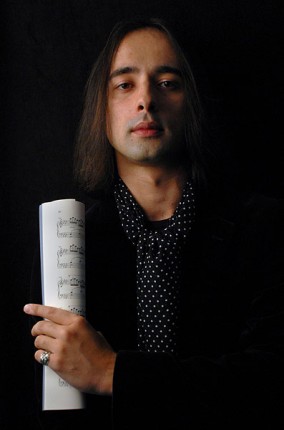Miami Piano Festival opens with a golden night of Liszt

Misha Dacic
The Miami International Piano Festival celebrated the 200th anniversary of Franz Liszt’s birth with the second part of a daylong marathon recital by Misha Dacic Sunday night at the Broward Center’s Amaturo Theatre in Fort Lauderdale.
Liszt’s flashy keyboard showpieces are treasured by pianophiles. Certainly Liszt’s works were boldly innovative, harmonically daring and technically daunting.
Still his scores are best sampled in small doses. A full evening of Liszt’s overheated rhetoric and wild pyrotechnics can be wearying. That Dacic often found a compelling subtext beneath the keyboard high-jinks was a singular triumph.
For Liszt fanatics, his program was likely golden; for nonbelievers, Dacic offered pianism that could transcend the sometimes shallow music on display.
At his American debut at the Miami Piano Festival in 2003, Dacic exhibited brilliant technical acuity and fearless virtuosity. Subsequent performances suggested those impressive chops were not always wedded to a greater artistry and expressive musicianship, with a sense of color and contrast sometimes in short supply. This program of late Liszt works revealed a more seasoned, relaxed pianist with mature interpretive instincts.
Daunting fistfuls of notes make the Fantasie and Fugue on the Theme B-A-C-H a keyboard minefield. Dacic not only met the challenges head on but imposed a sense of grandiose structure on a score than can seem rambling and incoherent. This burst of bravura was a mere warm up for the pianist.
Triomphe Funebre du Tasse (a transcription of the final section of Liszt’s orchestral tone poem Tasso, Lament and Triumph) is one of the composer’s most interesting scores, harmonically adventurous and replete with sudden changes of meter and pulse. While skillfully projecting the score’s heroic aspects, Dacic was most effective in the quiet moments, his supple rubato, tonal coloration and urgency channeling poignancy and eloquence.
The Mephisto Waltz No. 3 is a contrasting companion piece to the more familiar score in this series. Lighter and modernist in tone, Dacic brought lilt as well as demonic power to this cameo.
Few pianists dare attempt the Valse Infernale from Reminiscences of Meyerbeer’s Robert le Diable. This tour de force seemingly requires two pairs of hands crashing through octaves at top speed. Dacic’s display of power and sheer technique at ever-accelerating tempos was stunning and devilish indeed.
Aux cypres de la Villa d’Este: Threnodies I and II represent a more meditative and personal side of Liszt. Written during the composer’s last years when he was suffering from depression, these pieces largely eschew overt display. Dacic was both poetic and elegant in these surprisingly lovely pieces, his tonal shading and restrained dynamics enhancing an aura of rapt introspection.
As a fire-breathing finale, the awesome Dante Sonata offered an inferno of finger-breaking octaves and rapid hand crossings that span the range of the keyboard with a sense of unhinged abandon and tragedy.
While Dacic’s full-throttle bravura was impeccable, he was most effective in the central moments of calm. These softly lyrical interludes were beautifully assayed, the contrast all the more striking amid the surrounding tumult. Dacic wisely did not offer an encore. After climbing Liszt’s Dante mountain, anything else would have been anticlimactic.
Posted in Performances
Leave a Comment
Mon Mar 7, 2011
at 8:54 pm
No Comments




